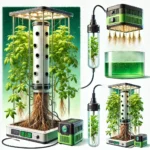Email: blogagri2@gmail.com
How to Design the Perfect Above Ground Garden Bed

Are you ready to unlock the full potential of your gardening space? Whether you’re a seasoned green thumb or just starting your horticultural journey, designing an above-ground garden bed can be the game-changer you’ve been looking for. Imagine lush veggies and vibrant flowers thriving in your backyard, all while saving time, effort, and soil quality! In this blog post, we’ll guide you through the essentials of creating the perfect above-ground garden bed that not only maximizes your yield but also elevates your gardening experience. Get ready to dig deep into tips and tricks that will have you reaping bountiful rewards—because it’s time to take your garden to new heights! 🌱✨
Introduction to Above Ground Garden Beds
Above ground garden beds are a game changer in gardening. They not only elevate your plants but also take your gardening experience to new heights. Imagine having a vibrant oasis right in your backyard, where the soil is just the right mix and the vegetables are within easy reach.
Whether you’re an experienced gardener or a beginner looking to dabble in growing your own food, above ground gardens offer numerous benefits that traditional gardening can’t compete with. With a little creativity and planning, you can maximize both space and yield while crafting an attractive outdoor feature.
Let’s dig into how you can design the perfect above ground garden bed that suits your lifestyle and needs!
Benefits of Above Ground Gardening
Above ground gardening offers numerous advantages that can enhance your gardening experience. One of the most significant benefits is improved drainage. Elevated beds allow excess water to escape, reducing the risk of root rot and other moisture-related issues.
Another perk is better soil control. You can customize the soil mix to meet specific plant needs, ensuring optimal growth conditions. This flexibility makes it easier to manage nutrient levels effectively.
Accessibility plays a crucial role as well. Above ground gardens are often easier on the back and knees, making planting and maintenance less strenuous for gardeners of all ages.
Pest management becomes simpler too. By elevating your plants, you can deter some pests while keeping an eye out for others more easily than in traditional garden beds.
Lastly, these garden beds can brighten up any space with their aesthetic appeal. They provide a neat and organized look that’s both functional and visually pleasing.

Factors to Consider Before Designing an Above Ground Garden Bed
When designing your above ground garden bed, location is key. Choose a spot that’s easily accessible for watering and harvesting. Avoid areas with heavy foot traffic to protect delicate plants.
Consider sunlight exposure too. Most vegetables need at least six hours of direct sun daily. Observe how shadows move throughout the day to find the perfect balance of sun and shade.
The type of soil you use can make or break your garden’s success. Rich, well-draining soil mixes promote healthy root growth. Test the pH if you’re unsure about your native soil quality.
Lastly, think about water access. Having a nearby water source simplifies your gardening routine. Drip irrigation systems can also be beneficial for maintaining consistent moisture levels without much effort on your part.
Location and Space
Consider the layout of your yard or patio. Ensure there’s adequate room around the bed for you to walk freely while tending to your plants. A well-placed garden can enhance both functionality and aesthetics.
Think about proximity to your home as well. Placing it closer means you’re more likely to check on it regularly, which keeps pests at bay and promotes healthy growth.
Also, account for how far away from fences or walls you’ll set up the bed. You don’t want any shadows cast over your budding greens! Proper planning ensures ample room for roots and foliage without overcrowding other elements in your outdoor space.
When designing your above ground garden bed, location is crucial. Choose a spot that offers enough space for your plants to thrive and allows easy access for maintenance.
Sunlight and Shade
Sunlight is a vital ingredient for any thriving garden bed. Plants rely on it to produce energy through photosynthesis, so choosing the right spot is crucial.
Observe your garden space throughout the day. Where does sunlight stream in? Are there areas kissed by morning light but shaded in the afternoon? Understanding these patterns helps maximize growth potential.
Some plants adore full sun and flourish with at least six hours of direct light. Others prefer partial shade, protecting them from harsh midday rays. Consider this when selecting what to grow.
If your space has more shade than sun, think about using reflective materials or planting varieties that thrive in lower light conditions. With careful planning, you can create an oasis even under trees or beside buildings, ensuring your above ground garden remains vibrant and productive all season long.
Type of Soil
Choosing the right type of soil is crucial for your above ground garden bed’s success. Not all soil is created equal, and understanding its composition can make a big difference.
A well-balanced mix typically includes topsoil, compost, and organic matter. This combination provides essential nutrients for plants while ensuring good drainage.
If you have specific plants in mind, consider their individual needs. Some may thrive in sandy soil that drains quickly, while others prefer loamy or clay-rich environments that retain moisture.
Testing your soil before planting is also beneficial. Soil testing kits are available at gardening centers and provide insights into pH levels and nutrient content.
Don’t forget to amend your soil as needed during the growing season. Adding more compost or natural fertilizers can boost plant health and yield significantly throughout the life of your garden bed.
Water Access
Water access is a crucial factor in designing your above ground garden bed. Without sufficient water, even the best-planned gardens can struggle to thrive.
Consider how far you need to transport water. If you’re using a hose or watering can, proximity to your water source will save you time and effort.
Think about installing a drip irrigation system for efficiency. This method delivers moisture directly to the roots, minimizing waste and ensuring that plants receive consistent hydration.
Rainwater collection systems are another option worth exploring. They not only conserve resources but also provide natural, chemical-free water for your plants.
Additionally, plan for drainage within your garden bed. Proper drainage prevents root rot and ensures excess rainwater doesn’t pool around your plants. Keeping these considerations in mind will significantly impact your gardening success down the line.
Materials Needed for Building an Above Ground Garden Bed
When it comes to building an above ground garden bed, choosing the right materials is crucial for longevity and functionality. Start with sturdy wood options like cedar or redwood. These types are naturally resistant to rot.
You’ll also need screws or nails for assembly. Opt for galvanized ones to prevent rusting over time.
For added stability, consider corner brackets. They’ll keep your structure secure, especially if you’re planning a larger bed.
Don’t forget about landscaping fabric! It’s essential for keeping weeds at bay while allowing water drainage.
If you’re looking to enhance aesthetics and functionality, think about using composite materials as well. They can offer a modern twist on traditional wood without sacrificing durability.
Finally, gather some quality soil mix that includes compost, peat moss, and vermiculite for optimal plant growth in your newly built garden bed.

Step by Step Guide to Building the Perfect Above Ground Garden Bed
Start by choosing the right size and shape for your garden bed. A rectangular design is popular, but circular or L-shaped beds can add creativity to your space.
Next, prepare the site by clearing away grass and weeds. Leveling the ground helps ensure proper drainage.
Now it’s time to build the frame. Use rot-resistant materials like cedar or composite boards. Cut them to size and secure them with screws for stability.
Once your frame is ready, fill it with a mix of high-quality soil and compost. This blend provides nutrients essential for plant growth.
If you want additional support for climbing plants, consider adding trellises or supports at this stage. They can enhance both function and aesthetic appeal as your plants thrive upward.
- Choosing the Right Size and Shape
Choosing the right size and shape for your above ground garden bed is crucial. It sets the stage for how successful your gardening experience will be.
Consider your available space first. Are you working with a small balcony or a spacious backyard? Measure carefully to ensure that you utilize every inch without overcrowding.
Next, think about accessibility. A wider bed might look appealing, but can you reach all areas easily? Opt for dimensions that allow comfortable access from all sides, especially if you’re planning on adding plants close together.
Shape matters too. Rectangular beds are popular, but don’t shy away from creative shapes like circles or trapezoids. Unique designs can add flair to your garden while maximizing space efficiency.
Finally, remember the height of the bed. Taller options are great for those who prefer minimal bending, making gardening accessible for everyone—especially seniors or individuals with mobility issues. The perfect fit awaits!
- Preparing the Site
Preparing the site for your above ground garden bed is crucial for success. Start by selecting a level area free from debris and weeds. This ensures that your plants thrive without competition.
Next, measure out the dimensions of your garden bed. Mark the corners with stakes or spray paint to visualize its placement clearly. This step helps you gauge space and accessibility.
Consider drainage as well. If water tends to pool in certain areas, avoid those spots. You want moist soil but not soggy conditions.
Lastly, clear away any grass within your marked area. Removing it reduces unwanted growth and pests later on. With a clean slate, you’re ready to build an inviting space for flourishing plants!
- Building the Frame
Building the frame is a crucial step in creating your above ground garden bed. Start by selecting sturdy materials such as untreated wood, composite boards, or even bricks. Each option brings its own aesthetic and durability.
Measure out your chosen dimensions carefully before cutting any pieces. A rectangular shape is popular, but feel free to get creative with curves or hexagons if you’re feeling adventurous.
Assemble the sides first using screws or brackets for stability. Ensure everything is level; this will help prevent water pooling and promote healthy drainage.
If you want extra height, consider adding legs to lift the bed further off the ground. This can also make it easier on your back when tending to plants.
Once assembled, inspect all corners and joints for strength—this frame will support not only soil but thriving plants too!
- Filling the Bed with Soil
Filling your above ground garden bed with soil is a crucial step in creating a thriving environment for your plants. Start by selecting the right soil mix. Aim for a combination of high-quality topsoil, compost, and organic matter to promote healthy growth.
As you fill the bed, layer the materials strategically. Begin with coarse materials like small rocks or wood chips at the bottom to improve drainage. Add your chosen soil mixture next, ensuring it’s well-aerated.
Don’t forget to leave some space at the top of the bed; this allows room for mulch that will retain moisture and suppress weeds later on.
Once filled, gently level off the surface without compacting it too much. This creates an inviting home for seeds or transplants while maintaining good airflow around roots.
Water thoroughly after filling to help settle everything down and check if any additional soil is needed before planting begins.
- Adding Supports and Trellises (if desired)
Adding supports and trellises to your above ground garden bed can elevate both functionality and aesthetics. These structures provide essential support for climbing plants, maximizing vertical growing space.
Consider using wooden or metal trellises that complement your garden’s style. They not only help plants thrive but also create an appealing focal point. Vining crops like tomatoes, cucumbers, and peas benefit greatly from these additions.
Space the supports strategically within the bed to ensure proper growth. A sturdy frame allows plants to reach their full potential without overcrowding or damaging neighboring flora.
You can also get creative with materials—repurpose old ladders or pallets for a rustic touch. This adds character while being resourceful.
Remember, adding these features does more than just support; they enhance airflow and sunlight penetration, promoting healthier plant growth throughout the season.
- Best Plants for Above Ground Gardens
Choosing the right plants for your above ground garden can transform it into a thriving oasis. Consider starting with leafy greens. Varieties like lettuce, spinach, and kale grow quickly and are perfect for smaller spaces.
Herbs also shine in these beds. Basil, rosemary, and thyme not only enhance meals but thrive alongside other vegetables. They require minimal space while offering maximum flavor.
For those who enjoy vibrant colors, incorporate flowers such as marigolds or nasturtiums. They attract beneficial insects and add a splash of beauty to your garden.
If you have more room to work with, tomatoes are an excellent choice. They love the sun and do well when supported by trellises or cages.
Don’t forget about root vegetables! Carrots and radishes can flourish in deep beds without competing for nutrients too much with surface crops.
Maintenance Tips for Your Above Ground Garden Bed
Regular watering is essential for your plants. Check the moisture level in the soil frequently. Water deeply but less often to encourage roots to grow deeper.
Weed control is important too. Pull weeds by hand or use mulch to suppress their growth. Organic mulches, like straw or wood chips, can conserve moisture and keep the bed tidy.
Fertilizing keeps your garden thriving. Use organic compost or balanced fertilizers every few weeks during the growing season. This provides nutrients without harmful chemicals.
Pest management should not be overlooked. Inspect your plants regularly for signs of damage or infestation. Use natural remedies when possible, such as neem oil or insecticidal soap.
Lastly, prepare for seasonal changes by rotating crops each year and refreshing soil as needed. Healthy practices ensure a productive above ground garden bed that flourishes through all seasons.
Creative Ideas for Decorating and Personalizing Your
Creating a unique and inviting space around your above ground garden bed can enhance both its beauty and functionality. Start by adding decorative edging made from stones, wood, or even recycled materials to define the area and give it a polished look.
Consider planting flowers or herbs along the perimeter for an added splash of color. Vertical gardens are another great way to maximize space while showcasing your creativity. You could attach small planters to fences or wall spaces nearby.
Adding trellises is not just practical; they also create vertical interest in your garden design. Climbing plants can weave through these structures, providing shade as well as beauty.
Don’t forget about personal touches! Garden signs with plant names or inspirational quotes can reflect your personality and passion for gardening. Upcycled items like old chairs, bicycle wheels, or wooden crates can serve as quirky décor that tells a story.
Lighting plays a crucial role too; string lights add charm during evening hours while solar-powered stakes illuminate pathways without hassle.
Ultimately, decorating doesn’t have to be expensive—it’s all about what resonates with you personally. Let your imagination guide you in crafting an above ground garden bed that feels uniquely yours while maximizing its potential yield.







